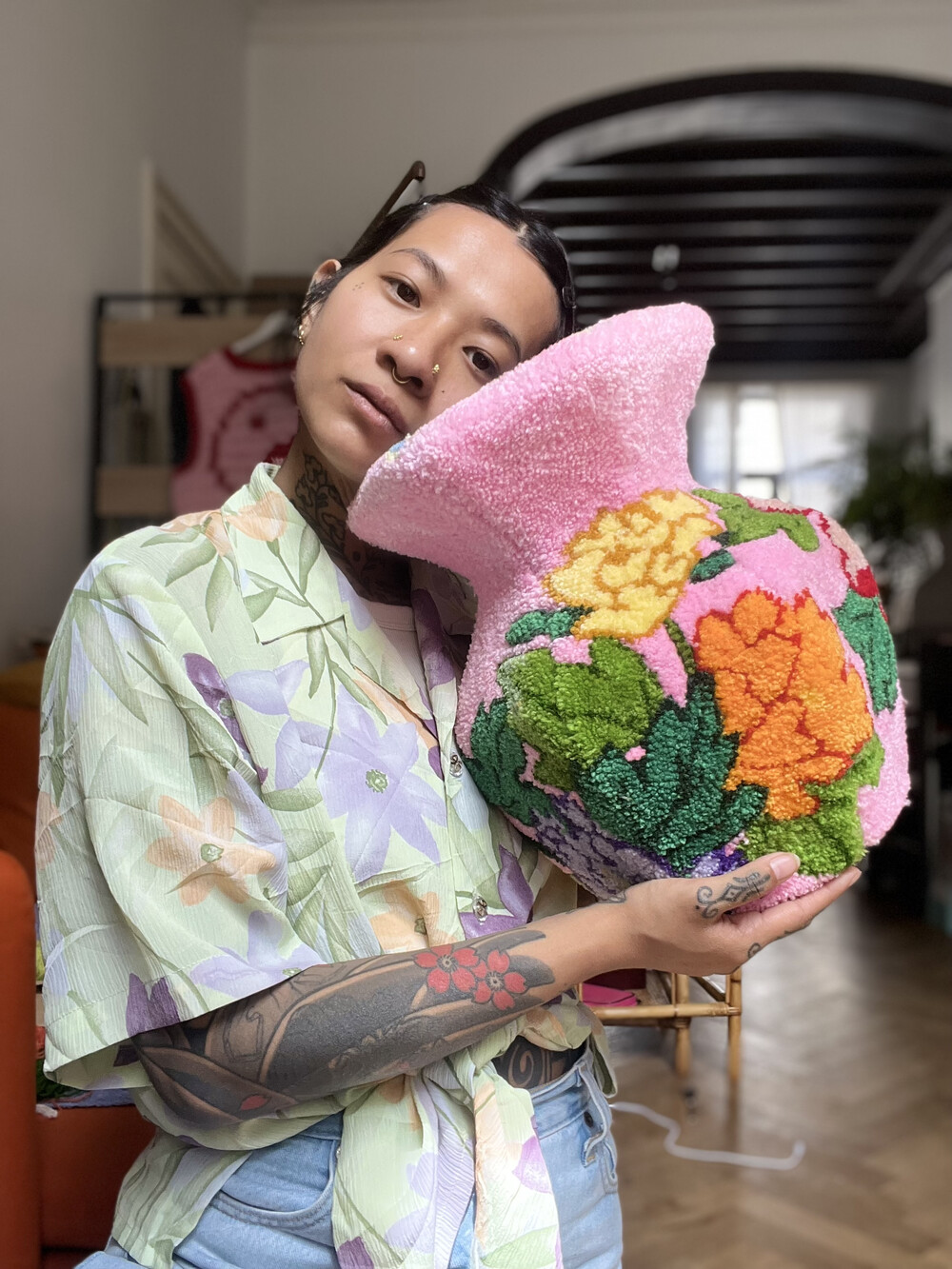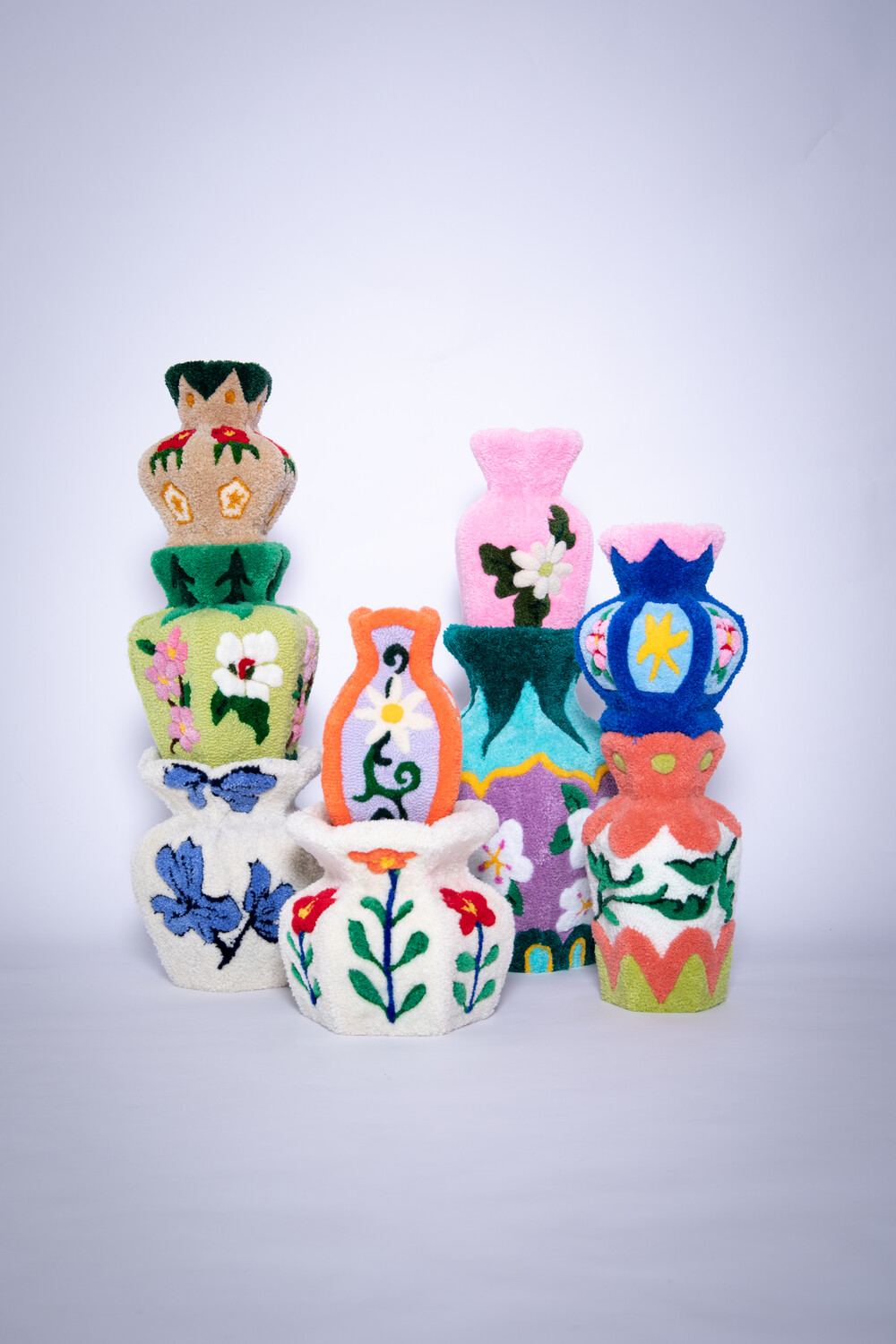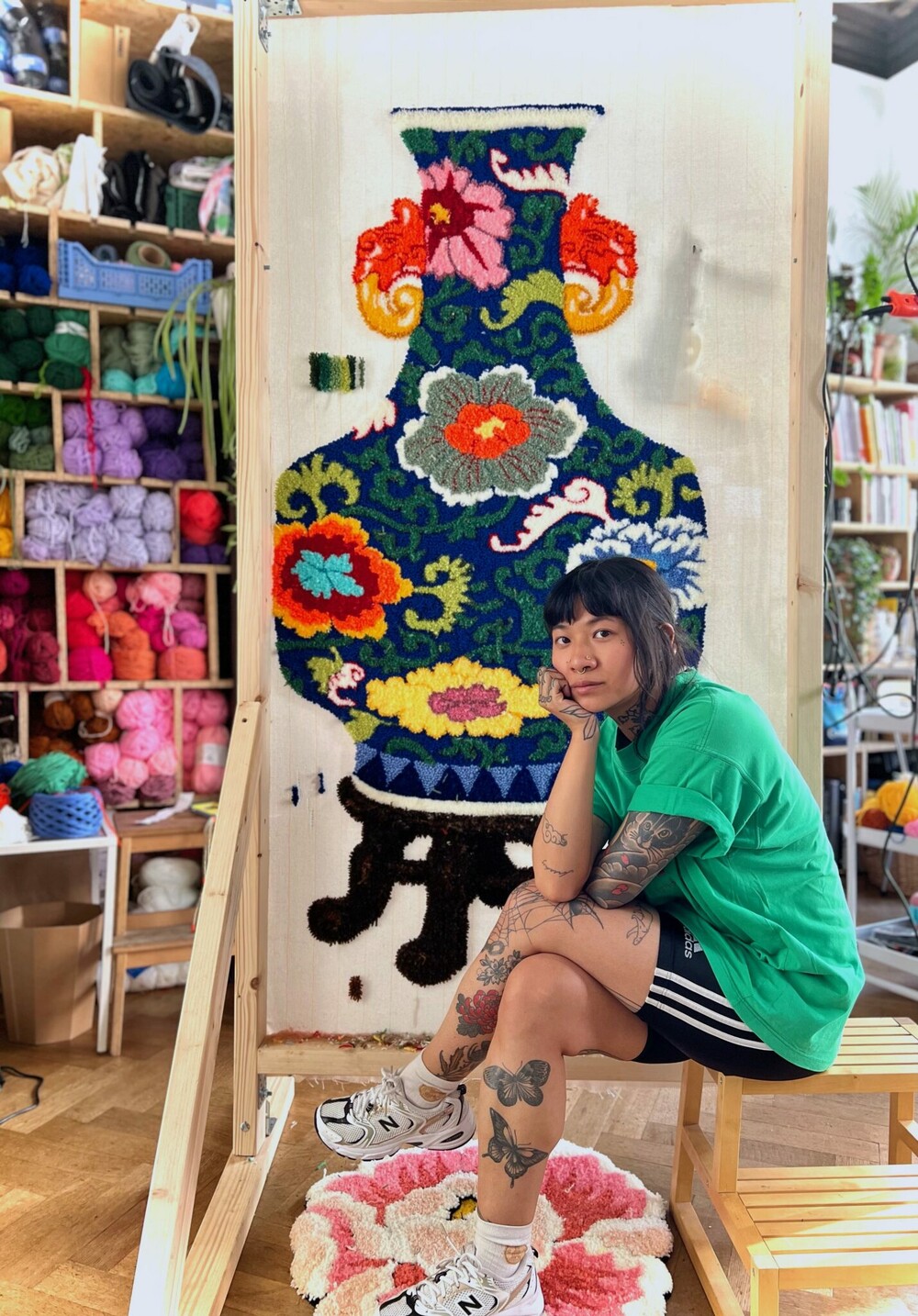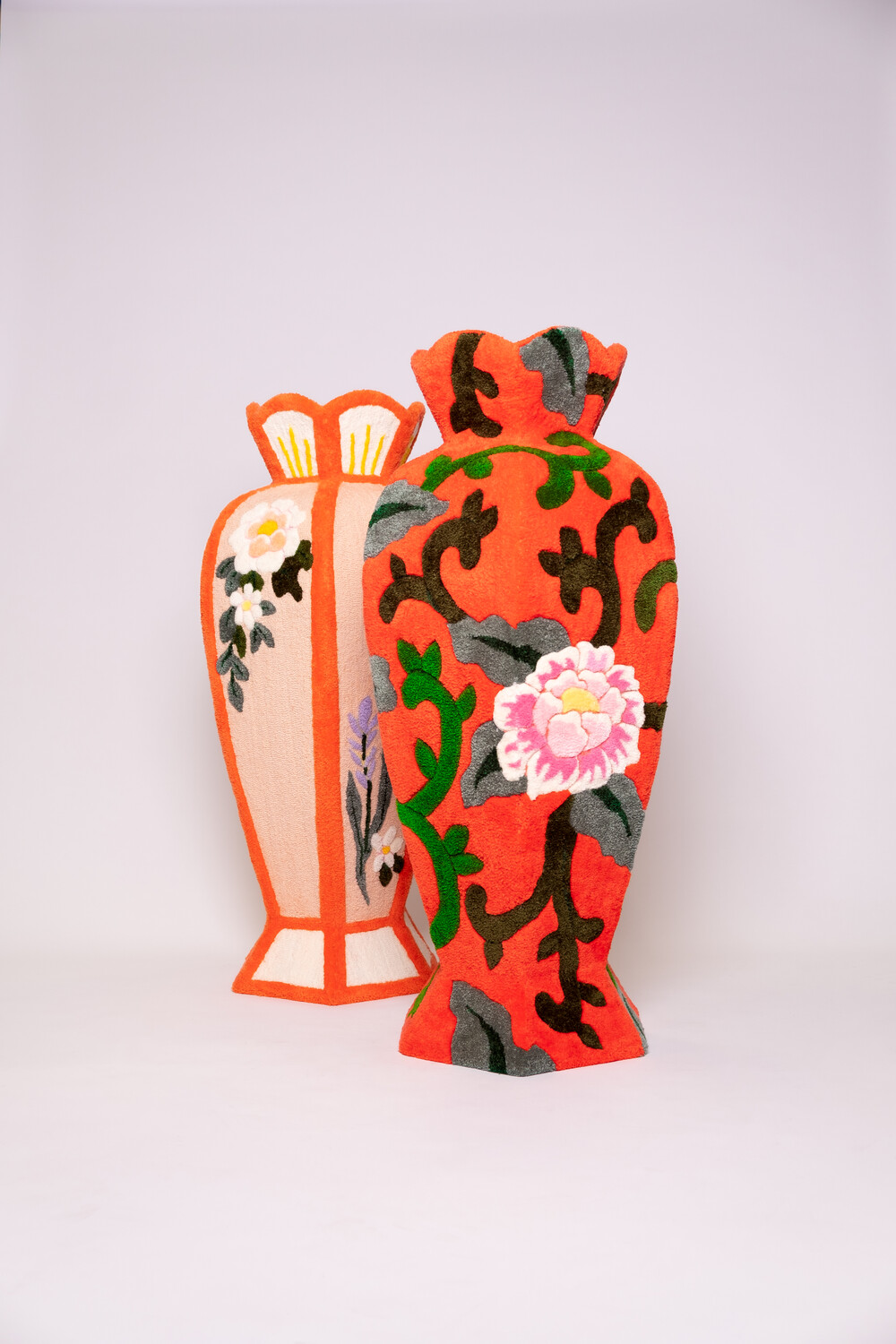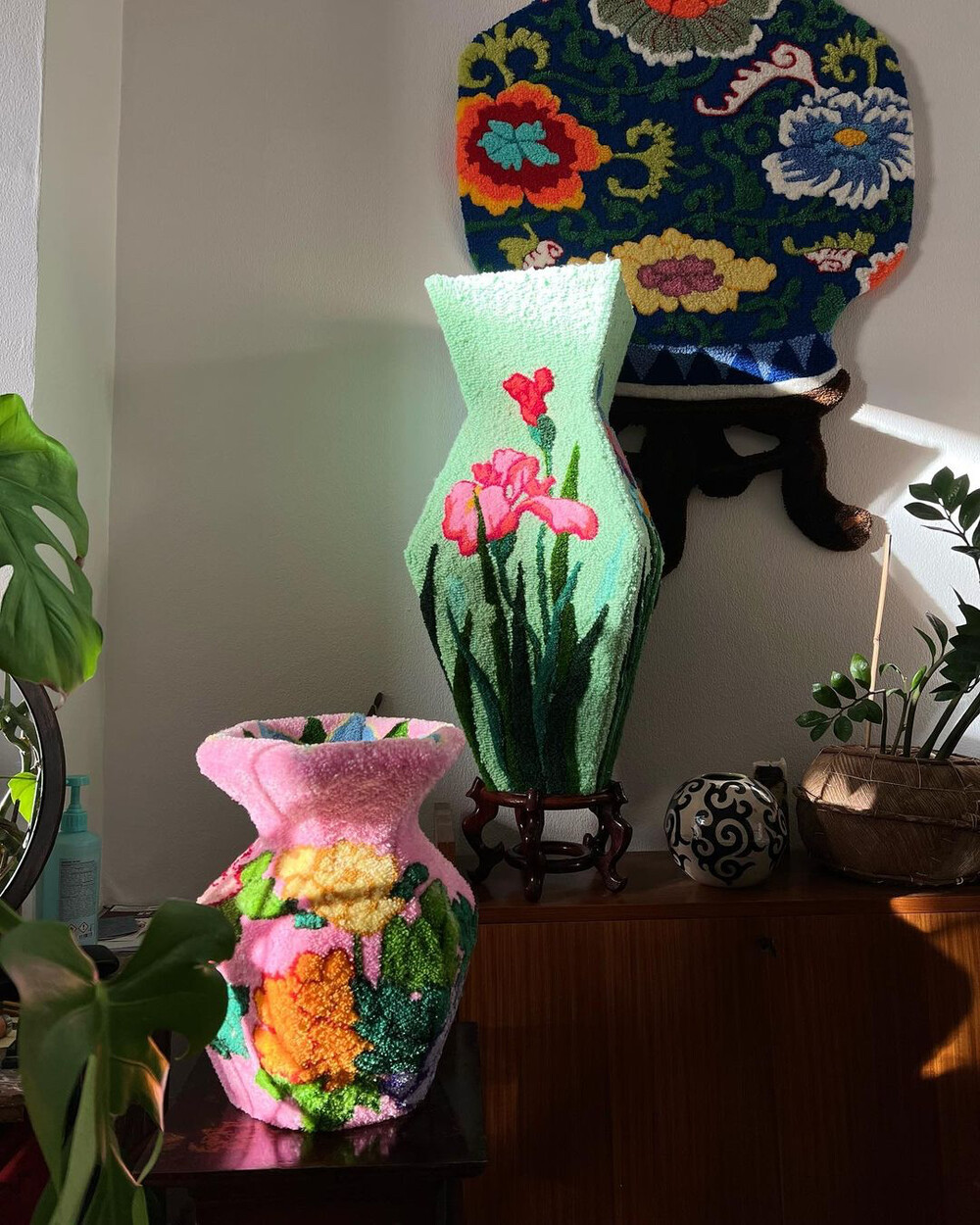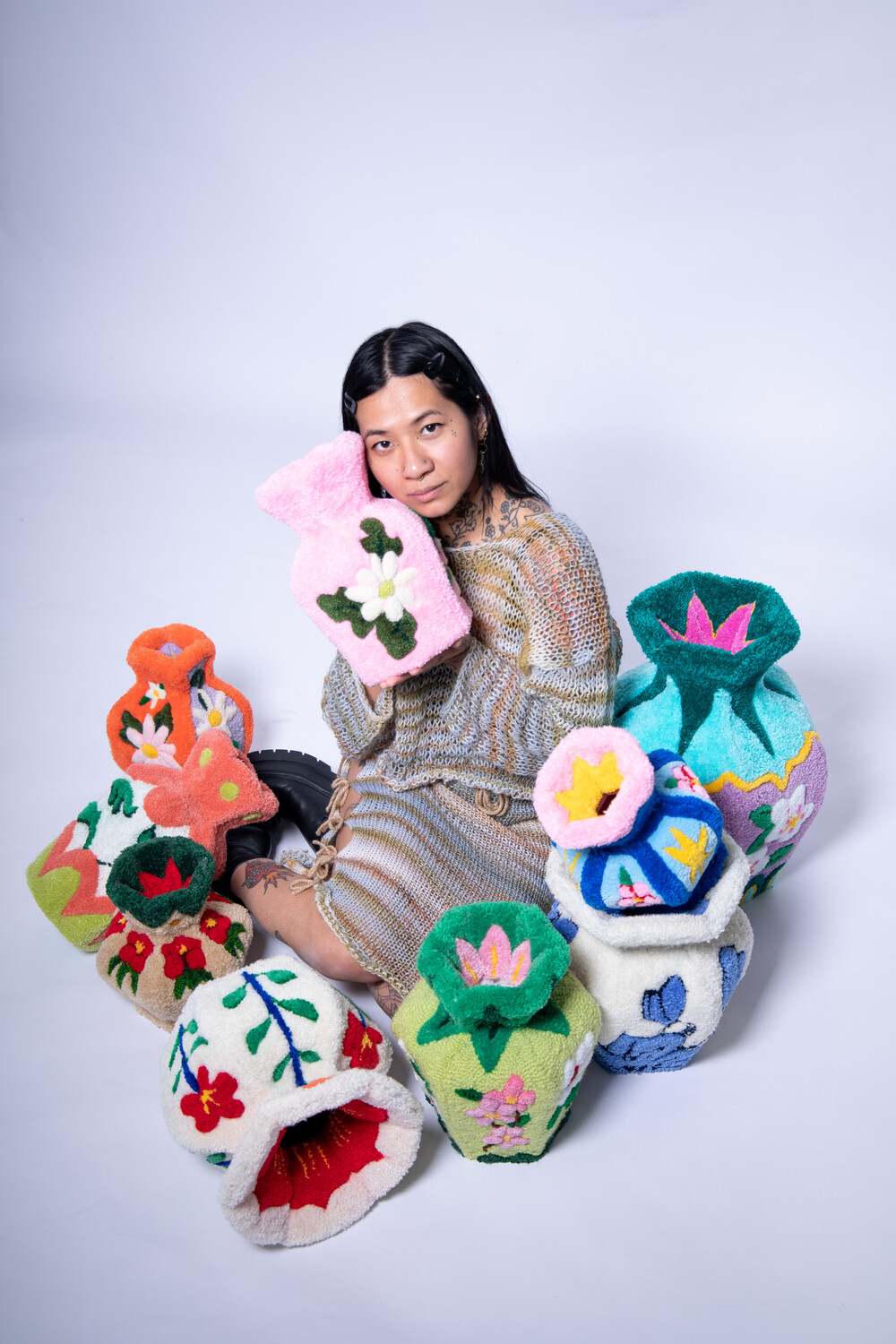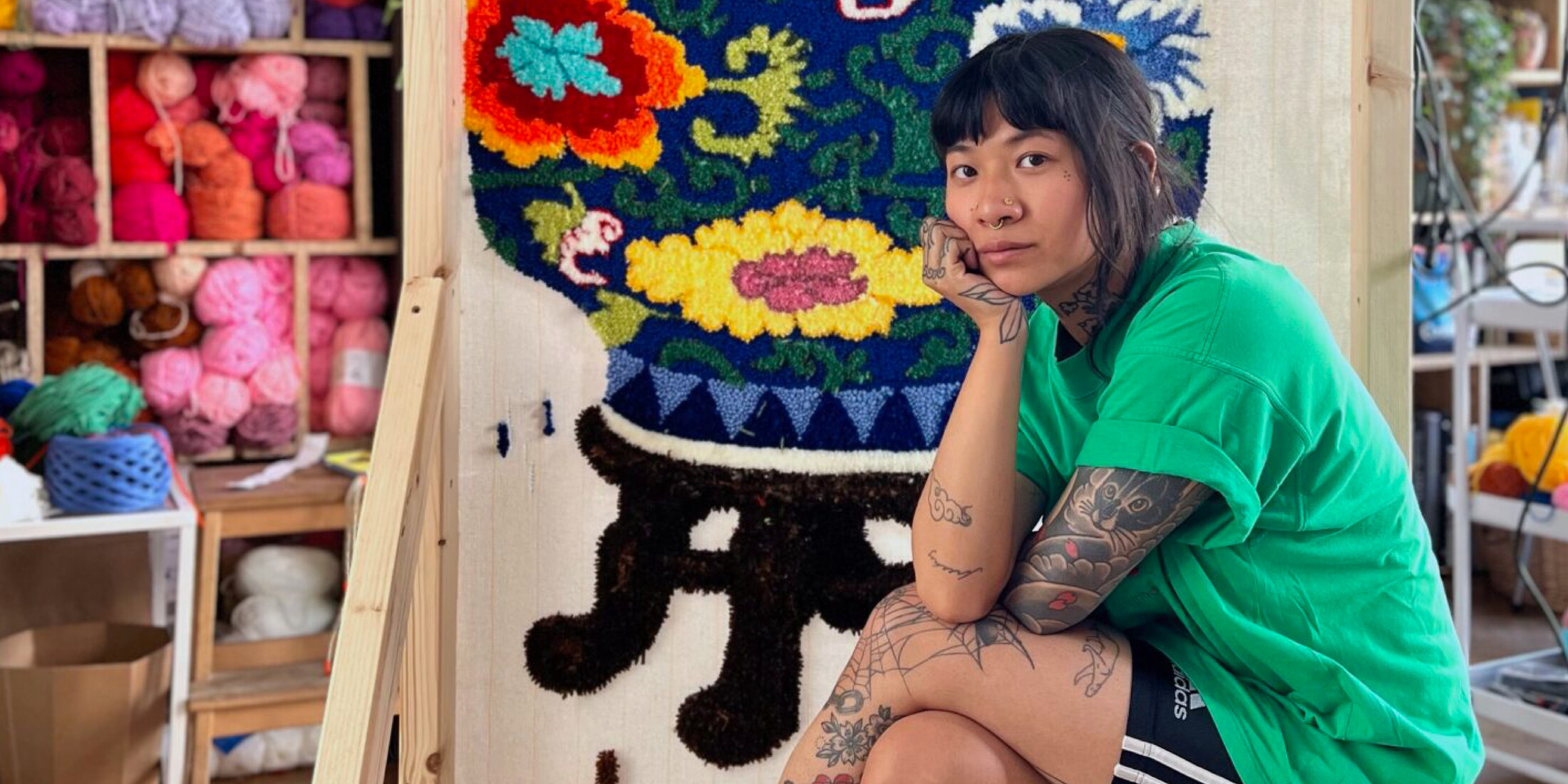
"I've always been inspired by Asian flowers, Chinese and Japanese vases with their patterns, colors and shapes. I wanted to create my own version of these vases."
Shishi San
Shishi San (1993) is a Brussels-based multidisciplinary textile artist who pushes the boundaries of practice with her fluffy vases. Each piece, beyond the object, is an ongoing search for new shapes, new color balances, and patterns both organic and symmetrical to her creations.
Adopted by a Belgian couple when she was young, Shishi San is originally from Vietnam. Inspired by this country from the outset, Shihsi San draws her inspiration from local folklore and traditions, adopting their visual identity while integrating a little of her personal history to create a work that represents her. Vietnamese culture shares a common history with China, Japan and Korea, and South and Southeast Asia thus play an important role in her practice.
Since 2022, Shishi San has been exploring the sculptural potential of tufting with new three-dimensional works. She has moved away from traditional tufting by creating her first fluffy vases, tufted vases in 3D. Their uniqueness, vibrant colors and fine patterns have made Shishi San one of the rising stars of the practice.
You can currently find Shishi San's work in our exhibition A(R)MOUR by Moroccan-Belgian photographer Mous Lamrabat. In the heart of Molenbeek, he made a photo series in collaboration with 12 Brussels designers, including Shishi. The series is an ode to Brussels creativity, but also to the cultural melting pot of our city. MAD Brussels spoke with Shishi San, an emerging talent in textile art, about her work, culture and inspiration.
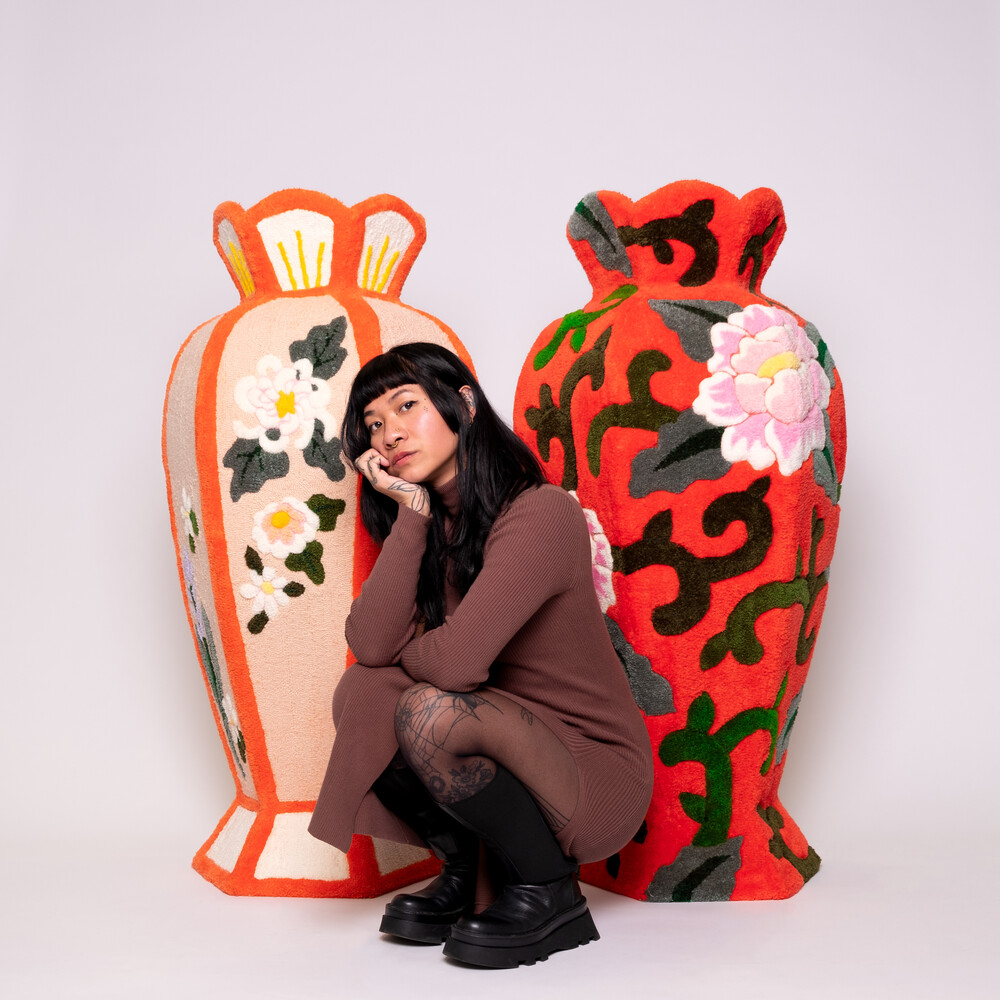
We'd like to know more about your background as an artist and what influenced the designer you are today.
"I've been interested in art and drawing since I was very young, and I love creating things with my hands. When I was younger, I studied art, but then I stopped and spent 6 years in sales, which gradually distanced me from creation. I learned embroidery, crochet, punch needle and later tufting, and since then I've worked exclusively with textiles. I'm very visual, I love working with colors and textures, and that's what got me into art."
As a textile artist, you mix various techniques. When and how did you discover these techniques? Why these techniques?
"When I was younger, I was already customizing my clothes with embroidery, making my own accessories and exploring my creativity. I also drew and painted a lot, but textiles offer more visual diversity, texture and relief, so I turned to this practice. I like working with fibers, because you can design everything from A to Z, just like with crochet or knitting. I can design my garment from start to finish, and that's satisfying."
"Shortly before confinement, I started punch needle stitching. It's a practice I found very slow because everything is done manually, stitch by stitch. It can be discouraging to work on a piece for several months, as inspiration and creativity seem to have faded away. That's when I discovered tufting gun, which enabled me to evolve more quickly and create what I imagined more easily. It's a technique where you use a gun powered by thread, which you press against a stretched canvas to make the thread pass through and create the surface of the carpet. I worked on larger surfaces than with embroidery or punch needle."
"I've always been attracted to the manual side of things, to produce an object yourself, to be part of this craft approach. Of all the techniques, I find tufting the most creative because it allows me to combine drawing, tufting and, more recently, a 3D element."
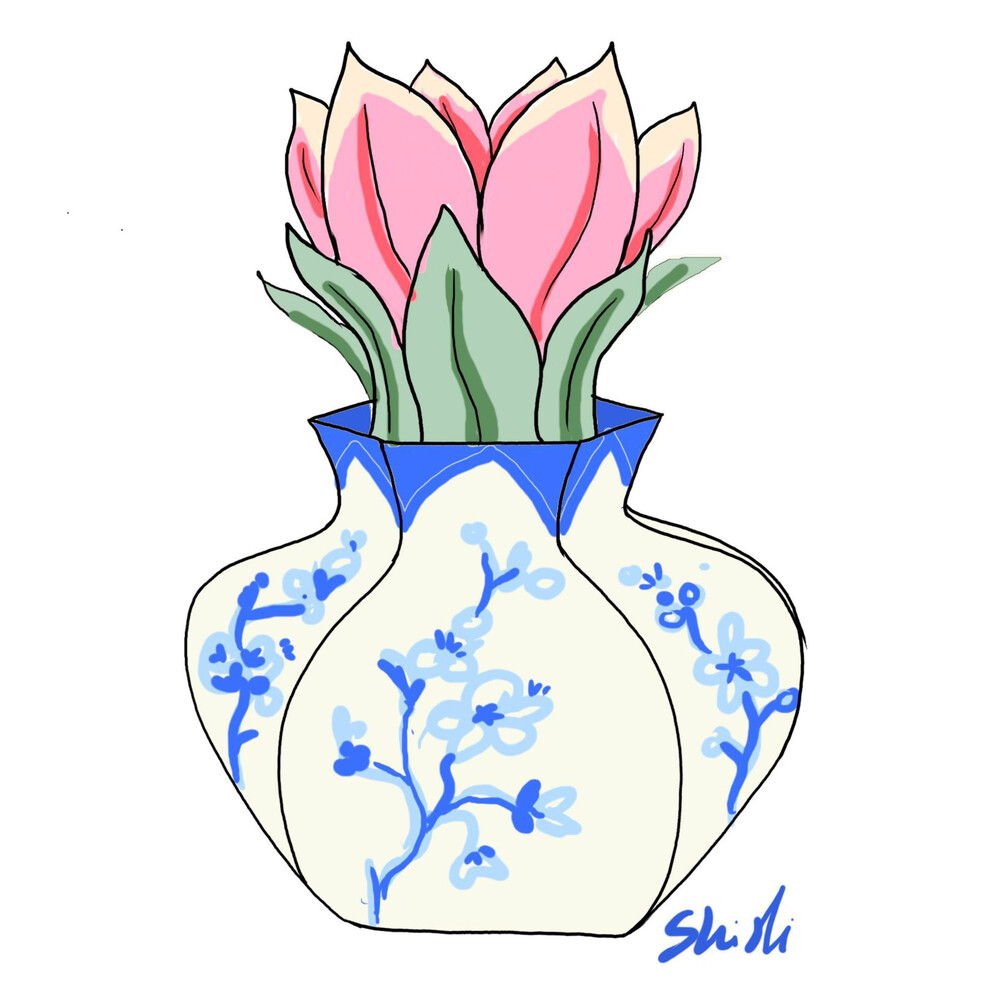
You're represented by the gallery, 'that's what x said', what does that mean?
"I entrust them with the relational work, the business part, and the communication, which means I have one less job to do. Thanks to them, I have the luxury to focus on creativity. If a customer wants to buy one of my pieces, he or she has to contact the gallery."
Once you've defined a new project, what happens? What are the stages in your creative process?
"When inspiration strikes, I draw directly onto the canvas and then 'paint' with the threads using my tufting gun. Unlike painting, nothing is definitive: if I don't like it, I remove the thread and start again. At first I draw in perspective, which allows me to visualize the project, then on the canvas I create a pattern, a model of the shape I want to make. Basically, I deconstruct the imagined shape, lay it flat and draw each part before assembling them."
"I use acrylic and never animal fibers. Initially out of conviction, then from thread to needle because of the lightness of this fiber and the variety of colors that the material allows, I'm less limited."
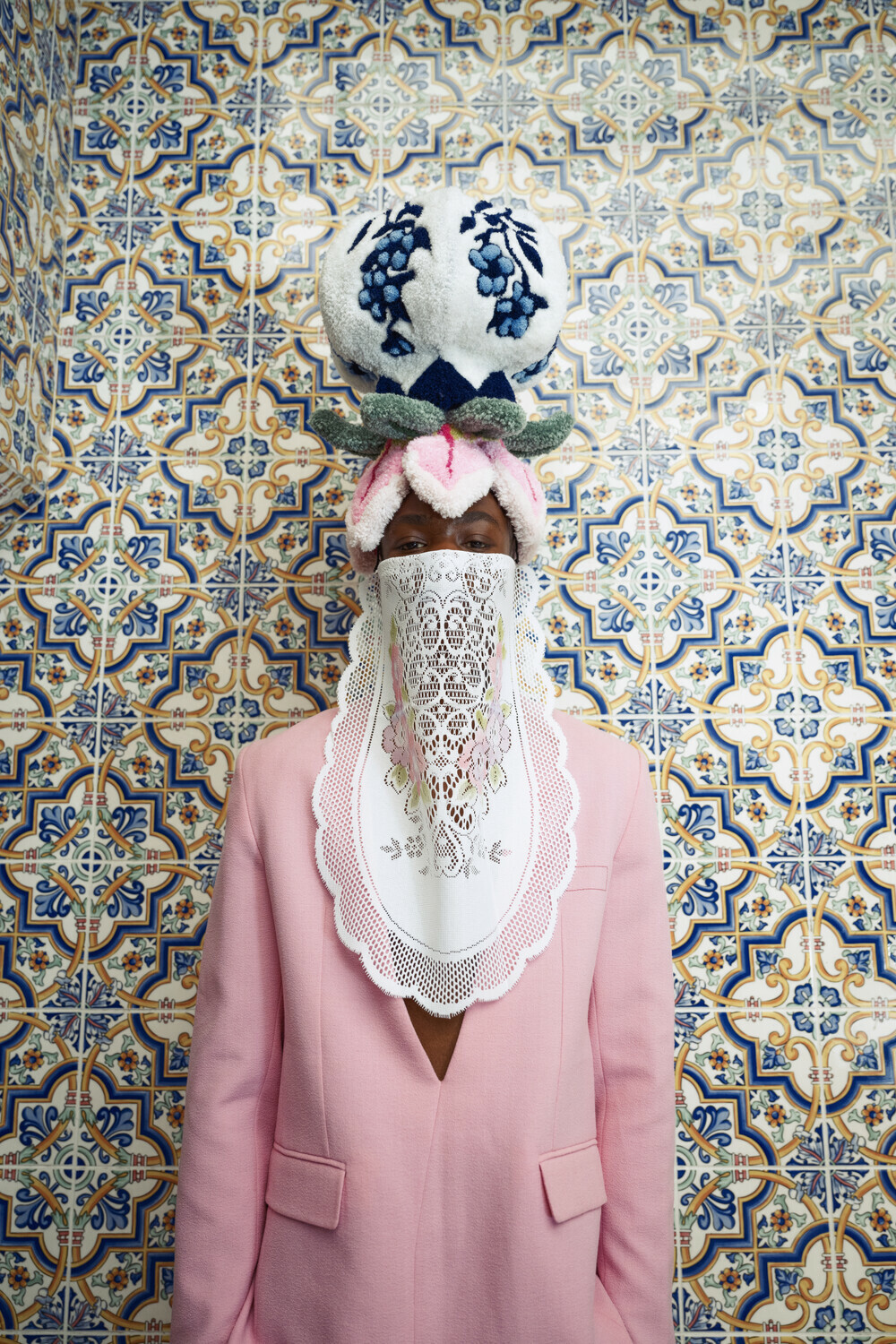
Your work is part of Mous Lamrabat's A(R)MOUR exhibition at MAD. Like Mous in his photographs, does your inspiration come from a cultural heritage?
"I've always been inspired by Asian flowers, Chinese and Japanese vases with their patterns, colors and shapes. I wanted to create my own version of these vases, inspired by my origins - I'm Vietnamese - my culture, my own experiences and their visual identity. In many Asian countries, flowers have a symbol: in China, for example, the Lotus represents happiness and goodwill."
"I'm often inspired by flowers because of the diversity of their shapes, colors and varieties. Above all, I try to express my personality and my feelings in my work, to bring something colorful and positive to the table. I'm completely autodidact and I place a great deal of importance on research. The important thing is not to copy or reappropriate things, but rather to understand and do things according to one's intuition and personality. "
"In his work, Mous draws much of his inspiration from the East, particularly the Maghreb and Morocco, under the guise of his Belgian eye, while my own sensibility seeks out Asia through motifs and flowers. The photo in the exhibition is a perfect blend of these cultural inspirations."
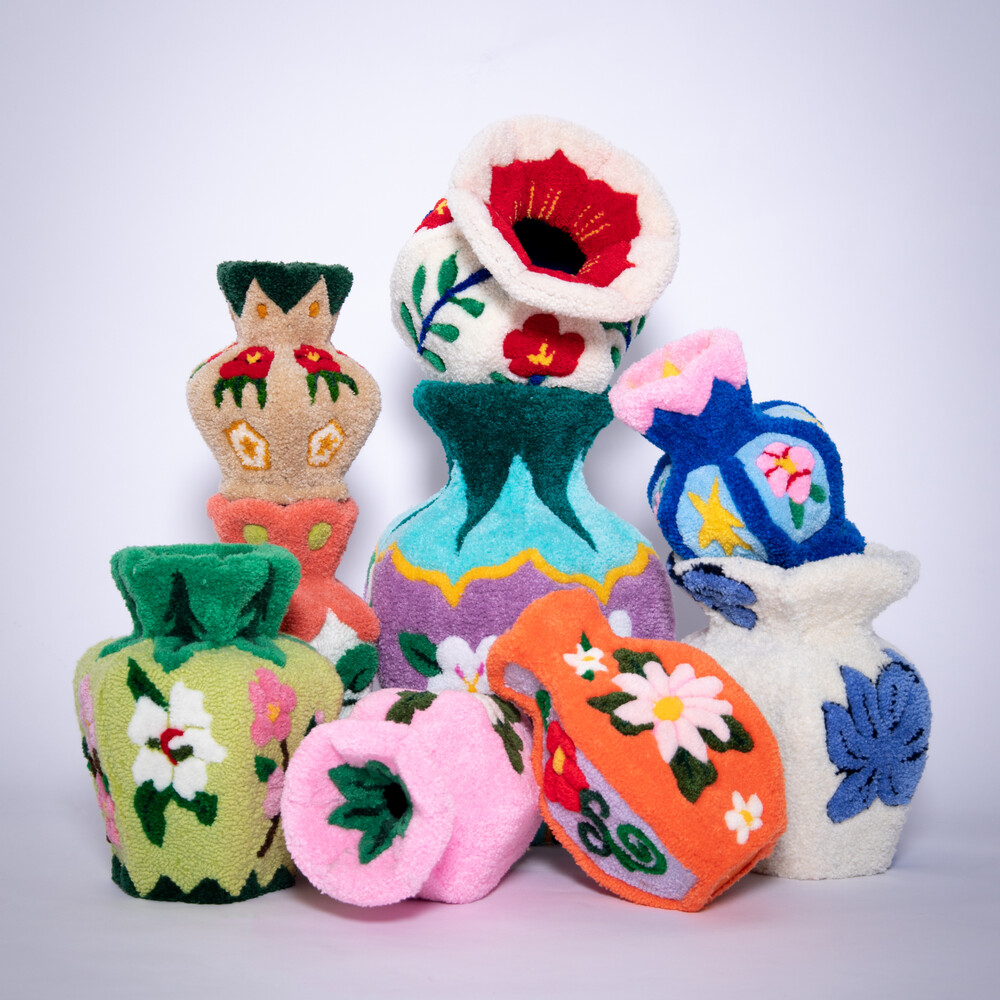
What's next for you?
"My work will be exhibited in New York at the Hashimoto Gallery from July 15 to August 5, in a group show on the theme of flowers. Then, with the gallery that’s what x said, which represents me, we're preparing a solo show starting in January 2024, where I'll be presenting an evolution of my vases."
Do you have any advice for young artists starting out?
"I'd say you have to be independent and give yourself the means to make a living from your passion. In my artistic process, I've always been interested in the origins of art and what I explore. Where it comes from, how it was done at the time and how it evolved, I think about meaning and concept. You have to be more curious, cultivated and autonomous. The more I work on an object, the more research I do, so as not to do something superficial. In this day and age, there's far too much cultural appropriation; everything is made very accessible with the virality of social networks and the Internet. At school, we used to study copyright and find out what had been invented in the past, without getting into the process of copying because it's 'cool'. You have to try and stand out from the crowd."
"I'm an autodidact, I learned everything myself. I think it's important to get informed, to understand a process before doing or repeating it. I think that's how you can say that you express what you do. You can't call yourself an artist or make art if you're just stupidly copying. You have to find a way of standing out to avoid the problems of borrowing and appropriation."
